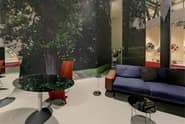
Driade Spa
29012 Fossadello di Caorso (Piacenza)
Italy
Driade was born in '68, some decades ago, in the same period as the trends that would have characterized the twentieth century: both the rigor of geometric and rational design and , on the other hand, the recovery of pop art and its influence on pop and radical design. Today, the "design landscape" is quite different, permeated as it is by the globalization and all- embracing digitization.
To understand Driade, you should visit its headquarters in Fossadello, near Piacenza.
I had been there often in the past but, I haven't come back for a long time. Seeing it again helped me to understand what it might be an "aesthetic laboratory" (as Driade likes to define itself) in these early twenty-first century. It would be useful to organize your path along the central hallway which goes through the building, a clear and rigorous sign, an architectural promenade on which offices and rooms, elegantly furnished, overlook. At the end of the walk you'll find a large room marked by high photographic panels representing the park of Würzburg castle, in Germany: a winter garden nestled in an endless time.
Everything aims to build an atmosphere of subtle aestheticism, in which the rational geometric structures, such as wall shelves made of wood or metal, can coexist with furnishings that have marked the last decades of design: from "Melaina" by Bonetto (I saw it again, after many years, while flipping through the catalog of the exhibition supervised by Emilio Ambasz in 1972 at the MoMA of New York: "Italy: a new Domestic Landscape") to "Due Cavalli" by De Pas, D'Urbino, Lomazzi, from the projects by Antonia Astori, Nanda Vigo, Enzo Mari, Philipe Starck, Oscar Tusquets, Borek Sipek, Tokjujn Yoshioka, Kazuyo Sejima, Ron Arad and many others, which have gone through more than forty years, up to artists such as the Chinese Xie Dong and the Indian Mann Singh.
In this sense, the headquarters is a perfect "aesthetic laboratory" for it expresses the idea of an overall image where everything contributes to create a work of art; a Wagnerian gesamtkunstwerk, where you can find pieces of architecture, furniture, objects, fabrics and carpets and where designers, photographers, graphic designers, web designers, and workers can meet together. There's something that reminds us of the Grand Duke Ernest Louis of Hesse who called, in 1899, the architect of the Viennese Secession Joseph Maria Olbrich to design the "Colony of artists", Mathildenhöhe, in Darmstadt: made of buildings by Olbrich himself and, among the others, by the young Peter Behrens. It was right Behrens to give the most acute definition of Darmstadt: "celebration of life and art."
It was meant to welcome artists, architects and designers in a place, symbol of aesthetic research, aiming at the popularization of applied arts in Germany, through the design and production of furniture and objects meant for retail.
The epoch of Mathildenhöhe was the early twentieth century, now we are in the XXI century: the age of the avant-garde, of rationalism vs. expressionism, of geometry vs. dreamy figures, has gone. The conflicts that characterized the design of the last century, if not yet disappeared, are certainly vanishing and have acquired a different sense.
This phase is marked by the multiplicity of languages that make it difficult to identify trends or relationships. A variety of authors, not always easily assessable and not all entirely acceptable, is building this century, which is characterized, in art and design, by pluralism, multiplicity of signs, and "idiolects" - as Roland Barthes called the use of language specific of a single author. The "Aesthetic laboratory" of Driade is fully relevant in this new and pluralist twenty-first century, while continuing to pursue its dream of "celebration of life and art". Vanni Pasca
